A season as Leeds United in Football Manager 2020; New features and changes in review
People love rituals. Most of us have several — whether we know it or not. One of mine happens annually, when the release date for the new Football Manager game is announced and I feverishly prepare myself for what will be at least a thousand hours of clicking Continue, occasionally interspersed with something more interesting, like clicking Team Selection or Play, instead.
Of course, that is Football Manager for those who don’t understand it. It’s just a series of screens filled with words and numbers. Statistics and tables. I mean, you might even call it boring, right? Well, not me. And not the millions of people who religiously download each new iteration of the game, even despite the fact that many releases bear more than just a passing resemblance to the last.
Football Manager 2020 is one of the roughly alternate releases that includes relatively few major changes, with the design team having instead focused on refining what’s there. It’s more of an iteration than a new version, but it still includes a few welcome changes to last year. With the beta version installed on my PC, I booted up and set about the task that I’ve been bent towards for the past twenty years — making Leeds United the greatest team in world football.
Setting myself up as a manager felt identical to how it has for several years, except that since I’ve gained a few pounds this year, my in game avatar looks like a sack of potatoes. He has no midriff, and his legs seem to be connected to his body in a way that looks implausible. My own physique being more akin to a triangle standing on its point seemed impossible to replicate, so I simply settled for claiming to be 10 kilos lighter than I am — something I’ve been doing since primary school.
Taking control of Leeds United comes with a pang of doubt in this iteration of Football Manager, and the words “who takes over following the departure of Marcelo Bielsa” seem to hang with the weight of responsibility. Thankfully, Marcelo leaves us with an excellent (albeit very thin) squad that is capable of challenging for promotion from the English Championship, and predicted by the media to finish in second place.
As a returning manager, I click no to most of the induction options, choosing only to be shown what’s new. Andrea Radrizzani comes to greet me, offering the usual opportunity to meet the squad, the media and the Assistant Manager Diego Reyes (who spends most of his time wondering what I’m saying).
Club Vision
Radrizzani then sits down and begins to talk about his vision, but something here feels very different to the last time we had this chat. Rather than him simply shrugging and accepting that no vision is as good as anything, he begins to list a whole raft of ambitions both for this season, and the next, and even the one after that. The Club Vision screen is now awash with objectives against which I’ll be measured, and each one has its own status report to measure how I’m performing.
This new addition marks one of the biggest changes to Football Manager 2020, and it’s been a long time (I mean literally 5 or 6 years) coming. Players no longer have to second guess what will or won’t make their board happy. If your overall security is languishing at maybe 60 or 70 percent despite all your wins and trophies, you should now be able to see that the board is unhappy with your transfer policy, or your failure to bring through enough young talent, for example.
Thankfully, Radrizzani and I are well aligned, and he wants to see Leeds become the force that I know they can be. He’s also keen to see youth players brought into the team and, where necessary, sold on for a decent profit. He’s financially astute and wants the wage budget tightly controlled, and he’s clear that I won’t be allowed to overspend in the transfer market.
On that note, Leeds begin the game with just over £900k available to spend, which in modern footballing terms is nothing. A lot has been said of Leeds’ transfer policy in real life, and if I were to summarise my feelings on the approach that Radrizzani and Managing Director Angus Kinnear take, it would be risk averse. Whilst that statement might suggest negativity, I’d say that I am begrudgingly pleased with how they manage the club in reality.
In Football Manager 2020 however, 900k is an infuriatingly small amount of money for a club the size of Leeds to be playing with, especially if their intent to achieve promotion in the 2019/20 season is to be realised. The game actually has a whole section on the Financial Fair Play (FFP) regulations, and how your team is doing in relation.
Despite some dealings of my own which don’t reflect what will happen in reality, Football Manager 2020 predicts that Leeds will make a £12.5 million profit in 2019/20, when the FFP regulations would allow them to make a £15 million loss before any sanctions are imposed. Above and beyond that, such penalties would only apply if the club failed to achieve promotion, meaning that it is possible to splash the cash and then go up (much as Wolves did).
Regardless of whether Radrizzani and Kinnear have the right idea when it comes to FFP or not, the budget is the budget, and since this is Football Manager and not reality, the first thing I needed to do was collect some free agents to strengthen the squad. An exhaustive, manual search supported by all seven of the Leeds scouts would be required, and the bad news is that at least so far, I haven’t discovered any absolutely outstanding options.
With Gaetano Berardi and Luke Ayling both crocked at right back, Leeds need an additional option here. Lewie Coyle remains on loan at Fleetwood and Robbie Gotts, whilst competent, can’t be relied upon. Alan Hutton begins the game available for free, having recently left Aston Villa. Despite being both old and extremely prone to picking up cards, Hutton is a very accomplished and experienced defender who fulfils the wing back supporting duties that I set for him well.
Elsewhere, Leeds are still short on central defenders, goalkeepers and strikers, whilst several of their best midfielders are secured via loans, the main one of course being Helder Costa, who joins permanently in July of 2020. To address these shortfalls, I picked up Jordan Archer (goalkeeper), Bicho (attacking midfielder) and Stefan Strandberg (central defender), all of who are more squad players than first teamers, but each comes with between a 2.5 and 3 star rating, which is good enough.
Also available on a free transfer in Football Manager 2020 are Wilfried Bony (formally of Man City and Swansea) and Lucas Silva, who was once signed for nearly £11m by Real Madrid. Bony refused to agree terms with me because he wanted a wage of nearly £20k per week, choosing to sign for RC Lens instead (and curiously accepting £3k per week less than I had offered him) whilst Lucas Silva, perhaps understandably, signed for Al-Ahli for £90k a week, despite having agreed to £17k with me.
Promises Promises
In negotiating these deals, a couple more of Football Manager 2020’s features came to life, including the fact that every deal must now begin with negotiation of promises. Players can now be offered a more realistic and descriptive set of statuses within the squad to describe their likely playing time. For example, I told Alan Hutton that he would be a Squad Player, and in actual fact, he’s played enough to be considered a Regular Starter.
Choosing the right amount of playing time is now much more important in pre-contract negotiation, as the personality of each player becomes apparent much earlier than it used to. There are several additional promises to choose from as well, and it’s not at all uncommon for a player to demand squad strengthening, intensive language courses, bonuses upon particular milestones and even to be played in a specific position (which I don’t think I ever saw come to pass in Football Manager 2019 even though the option existed).
Expected playing time versus actual playing time can now be seen on the Squad screen under one of the drop down options. This view shows both the comparison of expected versus actual time, as well as the players happiness with their level of football. This, whilst subtle, is a really nice addition in my opinion, since it’s a very fast and simple way of accessing the current happiness across the squad under normal circumstances. Clearly, other issues can still affect morale, but in general those things are exceptional rather than normal.
Development Centre
Before my first season began, it would also be necessary to work through the new Development Centre features that Football Manager 2020 introduces. The Development Centre replaces the U23 and U18 options in the main sidebar, and when clicked, it takes the player to a completely new screen which then presents the youth team set up at a summary level, with several options across the top.
The Leeds coaching team has a number of recommendations to make about the talented youngsters in the youth teams. The star performers (and those who are not meeting expectations) are now highlighted in two panels at the bottom of the main screen, along with their current development and any recommendations. The likes of Mateusz Bogusz, Kun Temenuzhkov and Lewie Coyle can be found here as potential first teamers, whilst Ryan Edmondson, Alfie McCalmont and Liam McCarron find themselves in the ones to watch panel.
Unsurprisingly to Leeds fans, Jay-Roy Grot seems to struggle, despite having a lot of potential, as do a few of the other players who begin the game out on loan — the likes of Laurens De Bock, for example. Sadly, despite a wealth of information and a feeling that the youth setup is now a living, breathing part of the club, the options for interacting with players out on loan remains fairly limited.
With a few loans organised and some shuffling of the pack, the last thing for a Leeds manager to sort out before the new season is shedding some squad players. Stuart Dallas (a player that tries hard but achieves little in my view) is worth an inexplicable £9.5 million when the game begins and he has little chance of starting ahead of Costa, Clarke, Harrison, Hernandez and Alioski, so he’s the first for the chop. O’Kane begins the game transfer listed, as does Ousama, and although I love him as a character, the injury prone Berardi (worth £4m) has to go as well.
Sadly, my efforts to sell these players was largely disastrous. O’Kane failed to attract a single offer, even despite my efforts and those of Victor Orta in his role as Director of Football with instruction to sell at any price. Similarly, no club would take a risk on Dallas for transfer, but Burnley were keen to loan him and offered to cover his wage, plus a sizeable contribution of £250k per month. Ousama left for just under £50k, whilst Berardi attracted several offers but, much as I had feared, he was injured before any of them could be finalised.
Fixtures and Formations
With the first match of the season against Bristol City looming, I would fall back upon a formation and tactical approach that has seen me to great success throughout the past few iterations of Football Manager, the only difference being that this Leeds squad is actually set up to make the most of it from the outset. My own tactical preference is not dissimilar to that of Bielsa himself, and I favour an intense pressing game with a lot of build up play through the middle and then very direct running on the wings.
The formation itself is essentially four, two, three one, with a box-to-box midfielder and a deep lying playmaker anchoring the midfield, and three attacking midfielders piling pressure onto the opposition. Strong, no-nonsense defending is required in the middle of the park, and my defenders play with an extremely high line to ensure the ball gets back into the opposing half as quickly as possible. Both wing backs are expected to cover a lot of ground to support both defensive and offensive maneuvers, whilst a lone striker operates to hold up the ball and turn in a high volume of crosses.
Leeds’ options on the wing are very strong at the beginning of the 2019/20 season, with returning loanee Jack Clarke a favoured option on the right and loanee-to-become-permanent-signing Helder Costa on the left. Another loanee in Jack Harrison as well as the utilitarian Ezgjan (Gianni) Alioski can cover either wing as needed, with little (if any) reduction in overall team potency. The talismanic Pablo Hernandez leads the line in an attacking midfield role with a clear focus on leading the line, but Mateusz Klich or new signing Bicho can deputise.
Another area of strength for Leeds United is the central midfield, where Klich again fits in well, as do Adam Forshaw, Kalvin Phillips and breakthrough youngster Jamie Shackleton. The unsellable Eunan O’Kane is far from the worst backup option ever, and with options like Bogusz and McCarron in the youth team that can be recalled from loan at certain points in the season, I felt I was well covered here.
Leeds certainly begin 2019/20 with some defensive challenges. “Calamity Casilla” may have seemed rubbish in latter parts of the 2018/19 season, but on Football Manager 2020 he’s a £12.5 million rated titan of the Championship. With the addition of backup keeper Jordan Archer adding to my options alongside Illan Meslier, keeping the sticks secure shouldn’t prove a problem.
The defence can be tougher to sort out depending on your luck. Ayling is my first choice right back with Hutton and Gotts as backup, whilst on the left, Barry Douglas is of Premiership standard, but also prone to injury. Thankfully, splitting his playing time with Alioski should be enough to keep both players happy, and Leif Davis is a good option if neither are available.
In the centre, Liam Cooper and Brighton loanee Ben White are the only real options, backed up in my case by Strandberg. If any two of these players are injured, I know I’ll be in trouble, an issue that has already proved a reality for Leeds this year, as Berardi is often fielded in place of an injured Cooper.
The Bristol City game came and proved to be a real occasion, with Leeds finishing 4-3 thanks to a hat-trick from Jack Clarke and a debut goal for Helder Costa. This began a run of 13 games unbeaten, with a 5-1 win against Nottingham Forest, a 4-0 win over Norwich in the Carabao Cup Second Round and a 7-0 demolition of Charlton as highlights. My preferred formation, it seemed, was reaping the rewards as Leeds maintained a steady league place between first and third spot, dropping only six points through draws with Brentford, Derby and West Brom.
When the first loss finally came, it was a televised game at Millwall that we lost 3-1 in an embarrassing capitulation. Jed Wallace, deployed on the right wing, proved too fast and too skilful for Barry Douglas on one of his off days, and Wallace shipped two assists and five key passes before netting himself — only to have his crowning glory ruled offside, much to my relief. The introduction of Alioski stemmed Wallace and turned the tide, but an 80th minute consolation goal for Helder Costa was too little, too late.
Squad Changes
A run of erratic form then followed, with only two wins and a draw from the next five games as the November loomed. Thankfully, the next few games saw my Leeds team picking up points at home against QPR and Blackburn with ease, despite a number of injuries beginning to affect the team. By this point Mateusz Klich was unhappy with his playing time and had been happy to agree a £10.5 million deal with Dynamo, whilst Berardi, now a year older, had a £1.4 million deal from Young Boys in the pipeline. Eunan O’Kane was removed from the transfer list, and nervously stepped onto the field for the first time in over a year to face Luton Town, seeing Leeds to another frustrating draw against weaker opposition.
As the players kicked off against Reading on the 26th of November, we were top of the league on 35 points, but only because of our exceptional goal difference. As it always seems to be in real life, the Championship league was extremely tight, with only six points difference between first and eighth place after seventeen games. We needed some clear water between us and the chasing pack, and the upcoming transfer window might prove invaluable, especially with the promised financial boost (about £5.5m retained) following Berardi and Klich’s sale.
The freedom to spend makes a huge difference in Football Manager, and there’s a huge difference between the kind of bargain you can obtain for £500k or £1 million, versus those you’ll pick up for less than say, £100k. With as much as £5.5 million in the bank, a seasoned Football Manager veteran can build a team that is capable of challenging for the Champions League with a few seasons under their belts. As such, the search for future talent began, whilst I also kept one eye on ensuring that the emerging gaps in my team were filled.
The Reading match itself was dull as ditch water for 80 minutes, and eventually ended in a 2-1 win with all goals scored in the last eight minutes. As the tedium played out (I use medium match speed set to show me comprehensive highlights) I was able to spend some time with the new match engine. Bearing in mind that my rig is powered by a GeForce 1080 and an i7 6700 processor, it is more than capable of running Football Manager 2020 with all options switched to their highest settings. The improvements in the match engine compared to 2019 seem fairly minimal, although the overall look is certainly at least slightly better.
One thing I did notice was that even just half a season in, I’d already witnessed several goals scored as a result of a shot being held by the goalkeeper, who then seems to step backwards over the line, resulting in a goal. It’s the kind of thing that just wouldn’t happen in reality based on the nature of the shots in question, so I wonder if there’s a bit of a bug there to be ironed out.
Mid-season Transfer Window
With the transfer window soon upon me, I turned my eye towards a few of the wonderkids that I hoped I might be able to afford. Leeds United’s scouting range doesn’t include such exotic climates as South America, but specific trips can still be arranged and paid for on an individual basis. I don’t feel that there’s much new to report in relation to scouting in Football Manager 2020, and you’ll still choose a package and then set your scouts up based on either a general approach, or in search of a specific kind of player for a short period — now for up to three months, rather than the one month limit in previous versions.
The first mid-season transfer window is a little late to pick up some of the most outstanding and well known European bargains, but Brazil and Argentina are excellent hunting grounds, and I quickly placed speculative bids for the best options that my scouts could find. Thiago Almada (much like Javier Saviola back in the day) is an excellent attacking midfielder that I bought several times in Football Manager 2019, as is Matias Palacios of San Lorenzo. Federico Ermacora offers an option as cover for left back, but he has a long way to go, whilst Melvin Bard is closer to first team football, but much more expensive thanks to his contract at Olympique Marseille.
As one or two of these transfers begin to come to fruition, my attention is once again drawn to the interaction between The Manager and The Board in Football Manager 2020. Radrizzani now sends me a monthly report ranking my performance against each objective based on letter grades. I notice that for the first time, he’s happy with my transfer activity this month, rating it an A-.
Oddly, whilst The Board are “Very Pleased” with my objective listed as “Sky Bet Championship: Win promotion” they seem much less happy with another, similar objective called “Win promotion to the Premier Division” which is rated as “Struggling.” I’m not sure if again, this might be a slight bug or it might be something to do with how the objectives are rated, but either way, these are one and the same in my view and in both cases, being in first place in the league is surely on course.
The Season Draws to a Close
As the football season draws to a close and Leeds United now comfortably atop the table, poised and ready to threaten the giants of English football once more, I reflect on my first season in Football Manager 2020. As I mentioned right at the beginning of this piece, 2020 is an iteration and not a new version. The changes that it introduces are minimal at best, but nonetheless welcome.
Football Manager fans don’t play the game for its new bells and whistles — and the game is all the better for the fact that the design effort is largely focused on ensuring that the experience is as tight and realistic as it always has been. I’d love to see material changes to the Team Talk and Press Conference systems in the next version, and I’d like to see Team Meetings and Player Chats expanded to include a lot more possibilities, but I’m glad none of these things were rushed in without thought or consideration to how they might impact the broader experience.
Whilst unremarkable, Football Manager 2020 is clinical in its execution and much like Leeds United, it remains (without a doubt) the biggest and best outfit in its particular division. There is no football management game that even comes close to it in terms of its realism and attention to detail, and nor is there another similar game that is as fun, or addictive. For new players, the inductions seem more interactive and useful than before, whilst for returning fans, you know the drill already and it’s business as usual.
Football Manager 2020 is available now on PC and Mac, and will also be available for Google Stadia. Meanwhile Football Manager Mobile and Touch is available for iOS and Android.
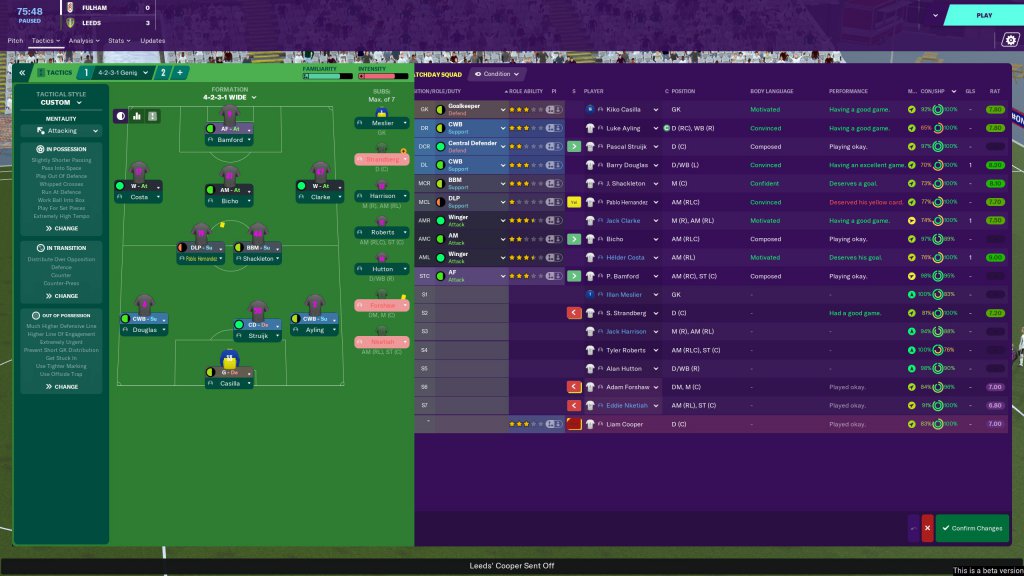
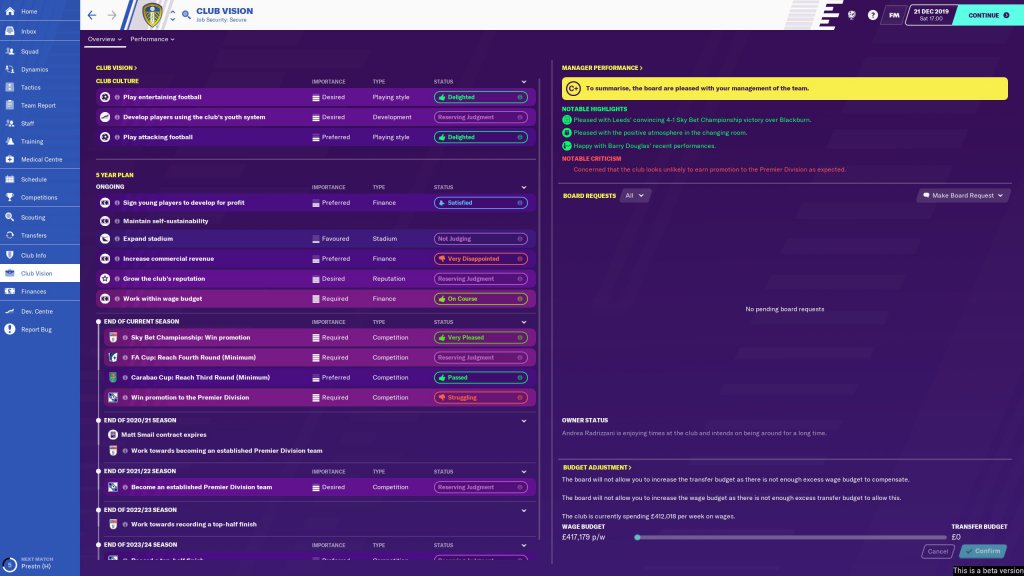
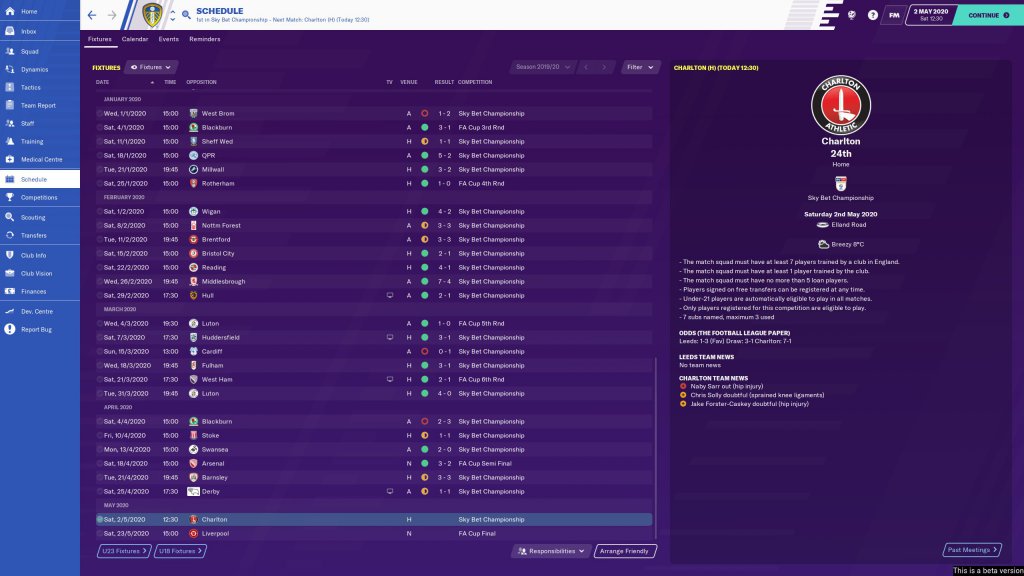
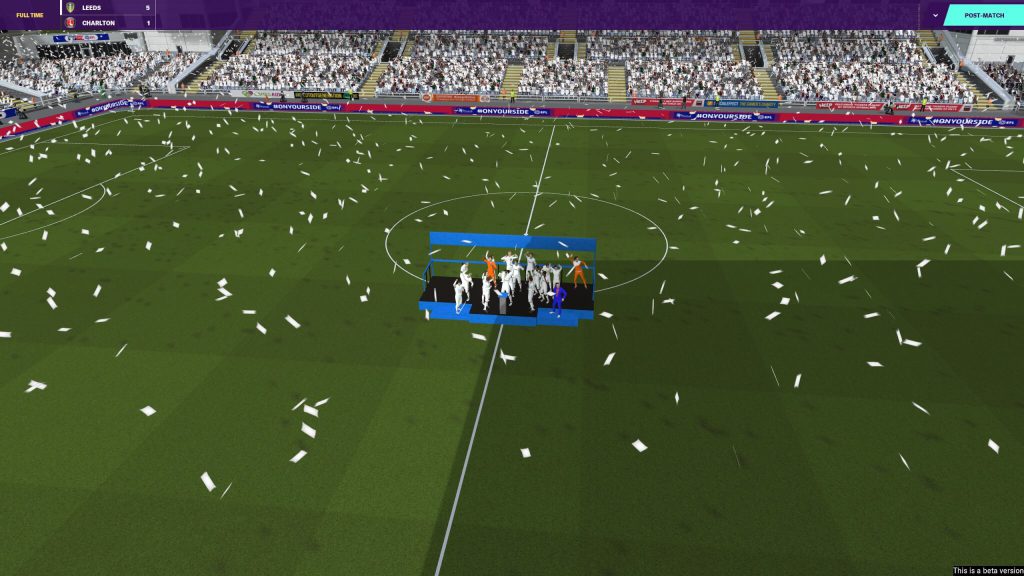
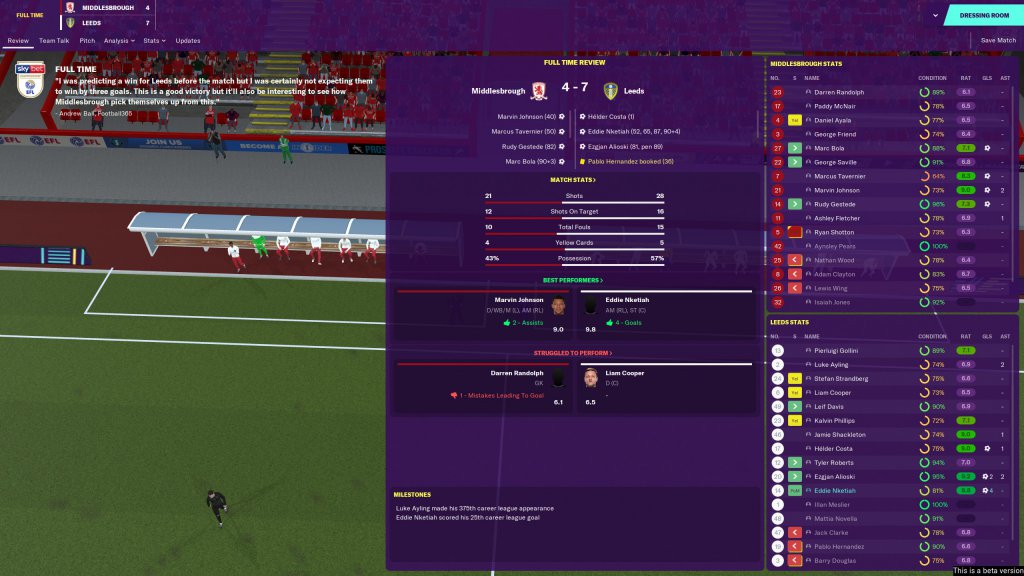
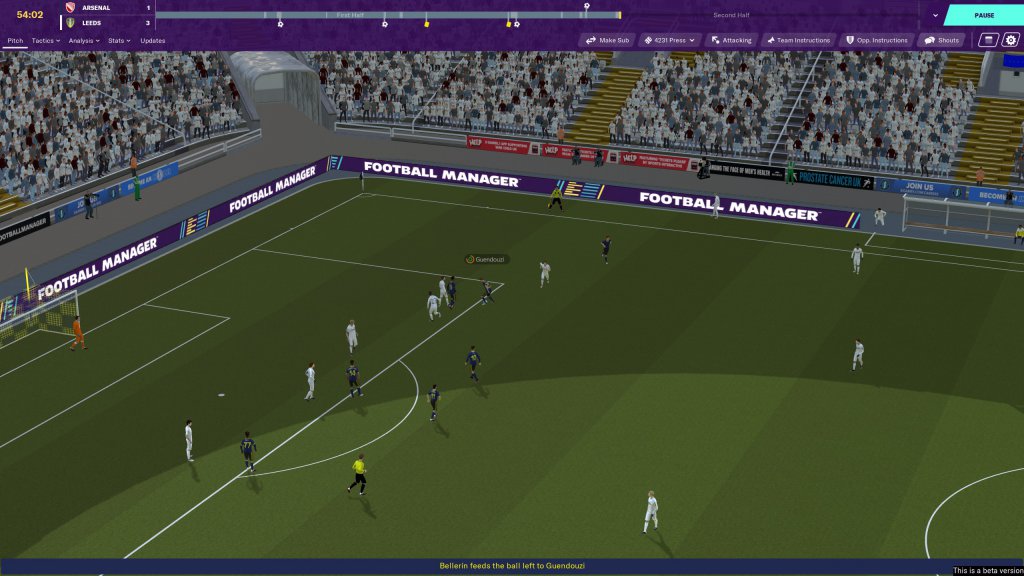
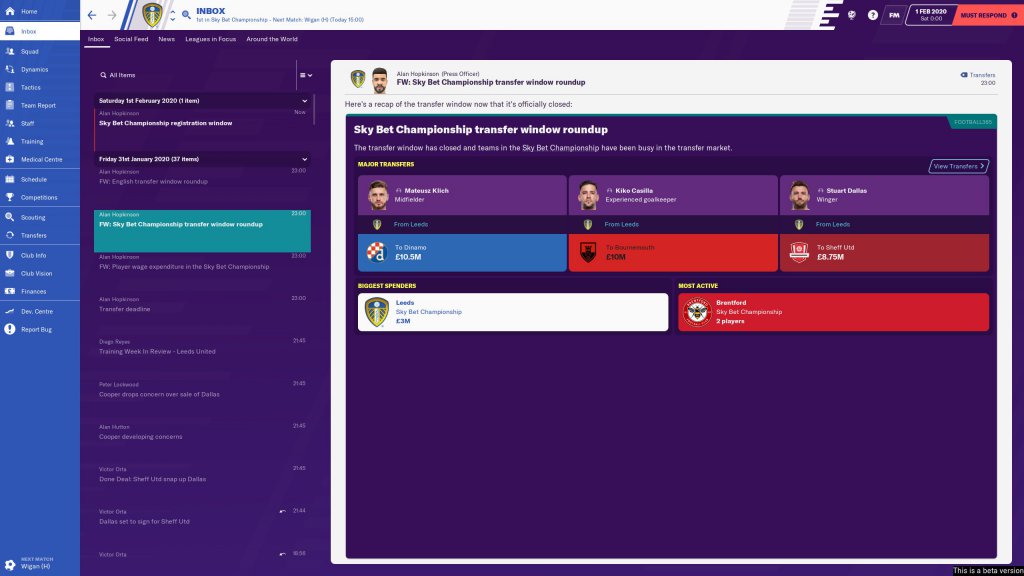
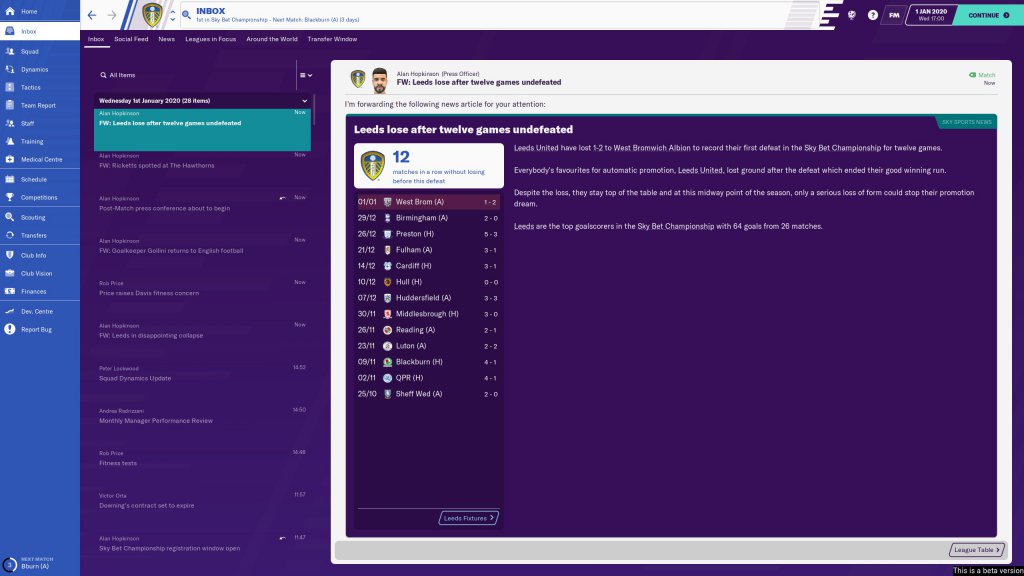
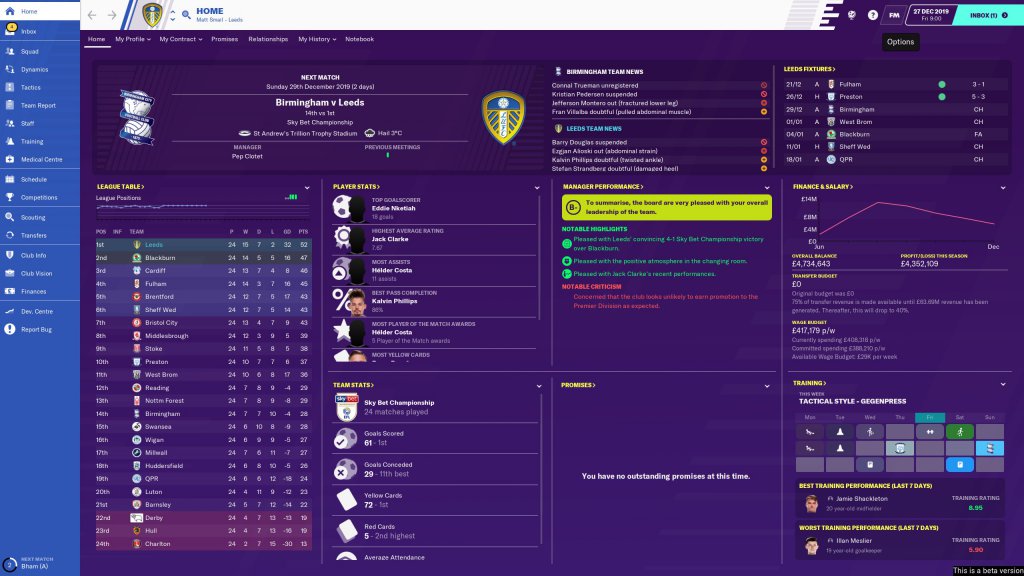
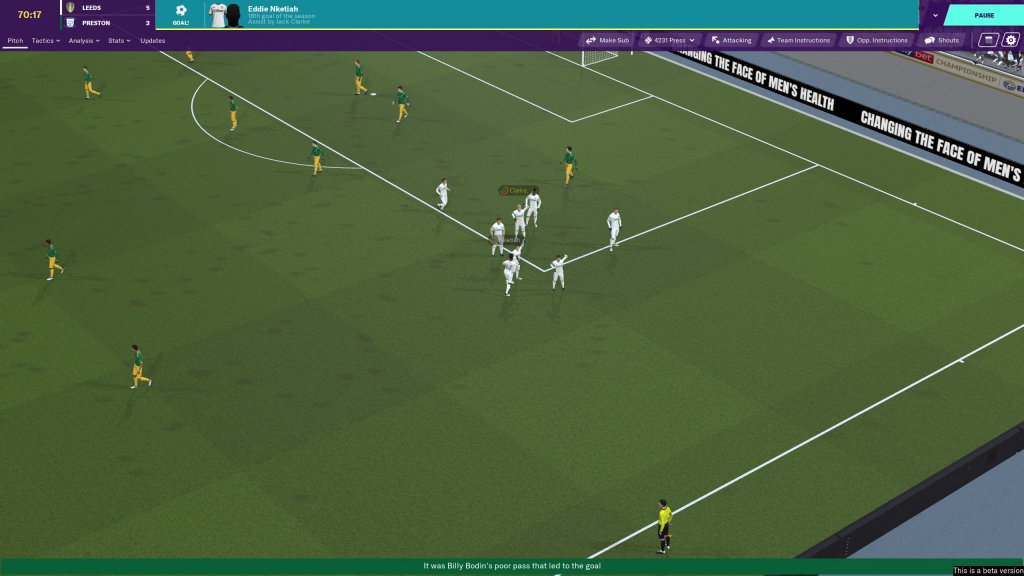
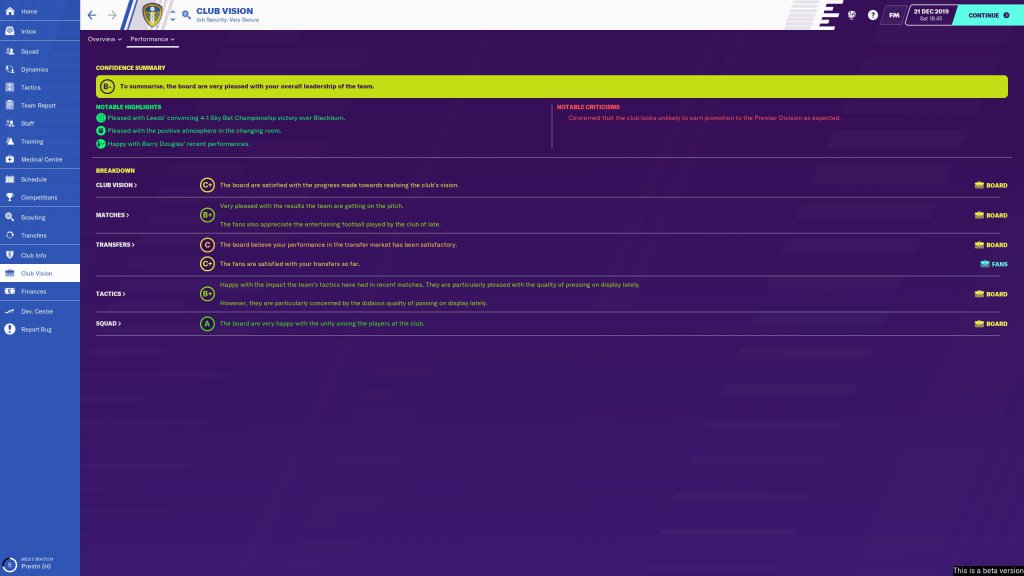
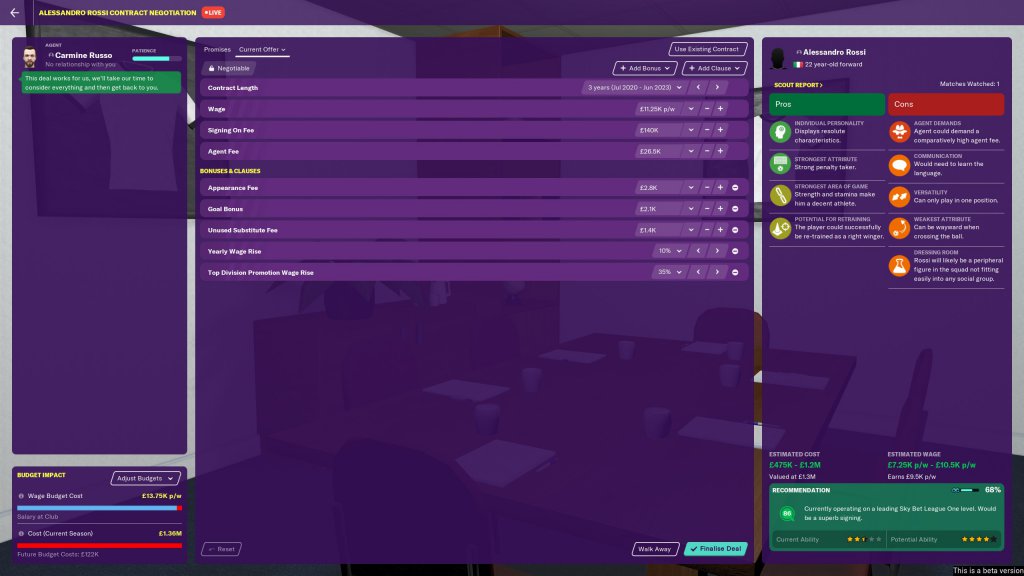
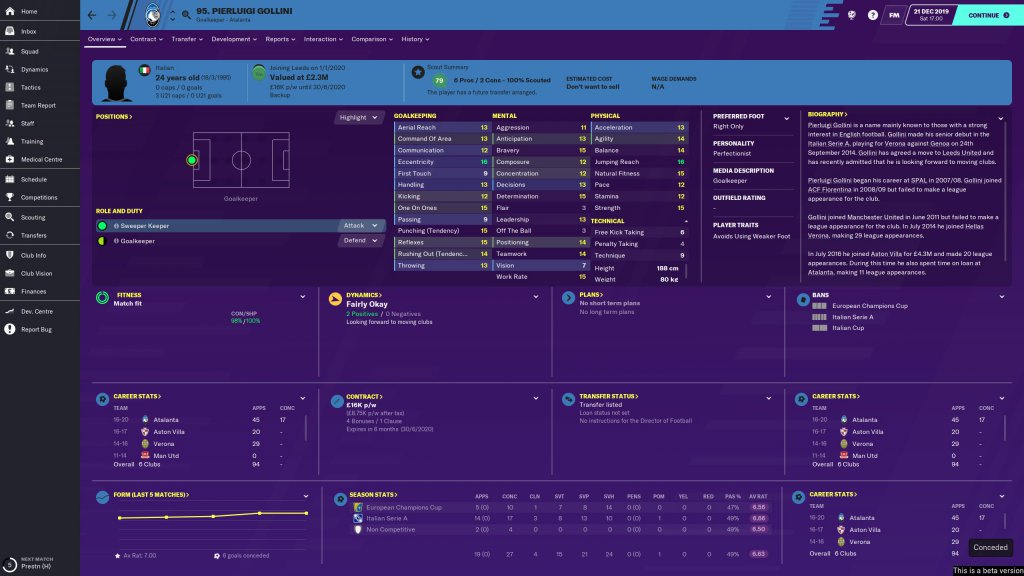
Comments are closed.